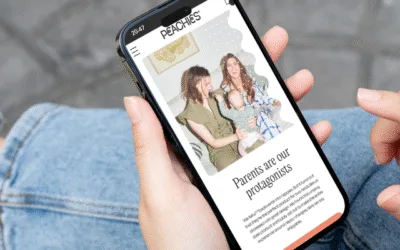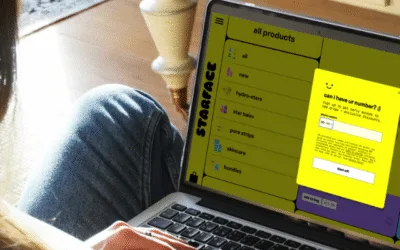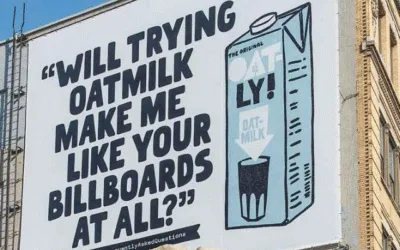Peachies beat Pampers by selling sleep, not nappies. Learn their Ladder of Why messaging trick to make your copy resonate.
How Dove, Moment & Bloom & Wild nailed their Father’s Day copy (and how you can too)
Father’s Day ads don’t have to be all grills and golf. See how Dove, Moment & Bloom & Wild are rewriting the narrative
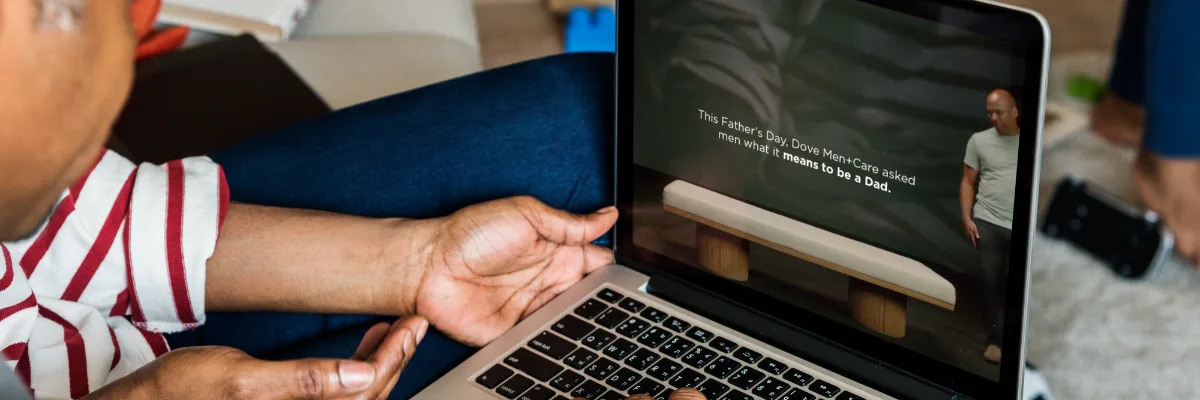
Get pro copy tips, branding tricks and e-comm insights directly to your inbox every Tuesday.
It’s that time of year again when our feeds are going to be full of ads for grills, nice whiskeys or beers, power tools and (for reasons still unknown) socks.
That’s right, Father’s Day is on the horizon.
And that means the collective idea of what it means to be a dad is reduced to little more than Ron Swanson stereotypes.
(And I say that as a dad of two who is currently (slowly) renovating a house, who enjoys nothing more than a good BBQ and a beer but who could not be less of a Ron Swanson type.)
👋 Quick heads up: unsurprisingly, this article talks a lot about dads and fatherhood. If that’s a sensitive topic for you (for any reason), feel free to skip this one.
PS. If you still want the practical takeaways without wading through the whole thing, just hit reply and we’ll send you a TL;DR version without the talk of fathers and dads.
If you read our post on inclusive writing a few weeks ago, you’ll know that expanding your language to better reflect the complexity of real people isn’t just the right thing to do, it also drives stronger brand growth. And not just in immediate sales, but in long-term growth, brand saliency, and pretty much every metric in between.
And while inclusive language often means making space for overlooked voices, it’s also about widening and re-examining how we talk about roles we might not immediately think to be mindful of. (Like masculinity and fatherhood.)
So this week, we thought we’d dig into how to write Father’s Day copy that feels right for 2025.
💡 This week’s big idea: It’s time to move away from the same tired Father’s Day tropes.
Let’s be honest: when it comes to Father’s Day, it’s *very* easy to fall into the same old tropes. The golf dad. The asleep on the sofa dad. The taxi driver dad. The loves a beer dad. The DIY dad.
Notice how none of those things are about being a dad but are mostly about doing things away from their children?
But according to Pew Research, fathers now spend nearly three times as many hours on childcare each week as they did in 1965 with 57 percent of dads saying parenting is central to their identity.
And a lot of marketing still ignores that.
In fact, a 2023 PriceWeber trend report found that most recent Father’s Day campaigns default to the “bumbling dad” or “guy off golfing” trope, mostly portraying fathers as either clueless or irrelevant in their children’s lives.
(You can thank The Simpsons and Peppa Pig for that.)
Which means there’s a huge opportunity for brands like yours to stand out by reflecting a more modern kind of fatherhood.
And here’s where inclusive writing comes into play.
Because inclusive writing isn’t only about pronouns or spotlighting minority groups. It’s about expanding how you talk about any identity and fatherhood is no exception.
And while other brands churn out Father’s Day copy chock-a-block full of tired tropes and nods to falling asleep in front of the TV might be easy, if your brand widens your lens to show dads managing schedules, handling tantrums, and providing emotional support, you’re not just going to connect with more customers, but it will sell better too.
(Not to mention, every time we portray Dad as the charming doofus, we’re reinforcing a system where emotional labour falls unevenly — and invisibly — on women.)
Plus, the data is on your side 👇
• Ads featuring emotionally present, caregiving dads outperform traditional “fix-it” spots on brand metrics and purchase intent. (International Journal of Advertising)
• Campaigns that break gender norms (think “dads who feel and share”) see +3.5 percent lift in short-term sales and +16 percent long-term growth. (We spoke about this before.)
• Even regulators are tired of dad jokes: the UK ASA has banned ads that depict fathers as inept caregivers.
So how do you write inclusive Father’s Day copy that sells?
Let’s dig into it 👇
Learn from last year’s Father’s Day campaign from Dove
Last year, Dove created this banger of a Father’s Day ad 👇
And in it, there’s kind of all the rules for how to handle Father’s Day copywriting.
✅ Celebrating all kinds of dads outside of the white dad stereotype, including step dads, grandads and father figures.
✅ Not a single mention of grills or fixing stuff or being useful.
✅ A strong focus on the bond between father and children.
✅ An even stronger focus on the love and care that dads have (rather than the value they provide)
✅ Showing dads as present and there for the children.
(It doesn’t hurt that this is a proper tear-jerker, either.)
Putting this to work: let’s do a Father’s Day brief together 👇
Look, it’s easy for brands like Dove to do Father’s Day well. Emotional storytelling is pretty much their whole deal.
So let’s make it harder for ourselves.
Let’s take what might just be the most common Father’s Day gift of all: beer. (No prizes for guessing what our dad is getting.)
Now, most beer brands fall into one of two traps:
- Trap 1: The “he’s earned it” narrative that puts dad as provider, whose reward is finally sitting down.
- Trap 2: Boiling dad down to the teller of dad jokes but nothing beyond that.
(There are some exceptions, but judging by our IG feed, this is still the norm.)
So what if we did better?
What if we wrote Father’s Day beer copy that actually reflected the real role modern dads play, in all its chaos, care, and emotional complexity?
Let’s give it a try 👇
This Father’s Day, we’re raising a toast to the legends you call dad.
To the ones who conquer monsters at 2 a.m., negotiate veggie intake like seasoned diplomats, and still remember which stuffed animal needs the extra good-night kiss.
To the ones who don’t have all the answers but listen anyway. Who say “I’m proud of you” just because.
To all the steps, the grands, the fosters, the co-s, the -in-laws, the bonuses, the twos, the chosen, the figures, the mums doing both…
To all the ones making the effort to be less “Because I said so” and more “Let’s figure this out together.”
To the ones laughing the loudest and smiling the biggest.
This Father’s Day, take a minute to crack a can of our brand new hazy IPArent with one of your first heroes.
See the difference being mindful can make?
It’s the same product at the same price point, but the story has changed. The way we feel about buying the beer for our father figures has changed.
Instead of reducing fatherhood to utility, we’ve:
- Recognised the broad spectrum of what “dad” can mean (including acknowledging multiple dads or father figures)
- Celebrated presence and closeness over provision and utility
- Shown emotional availability as a strength, not a weakness
- Reflected dads back to themselves the way they actually are in 2025, which is wanting to show up and do better and be emotionally present.
And so when we promote the beer at the end, it’s no longer a “thanks for always fixing our plumbing” moment that’s all-too-common. It’s now a celebration of the bond between father figures and children.
And that’s inclusive writing in action.
That’s how we can slightly shift our writing to show up in more human, more relevant, more inclusive ways.
So, how can you put this work for your brand?
- Start with a real moment. Pick one slice of dad‑life your product naturally fits into and start there. Midnight bottle warming? World Book Day panic? The first gnarly fall off a skateboard? Choose something the stereotypes never touch and zoom in on that. That way, you’ll start with a moment that feels real and tangible. (Which, as we always say, is the key to making copy 10x more memorable.)
- Focus on feelings, not functions. When you think of your dad, you probably think of how you felt when he came home from work or the time he took you camping or the look of pride on his face when you shared some big news. Focus on that, not the tasks he does or his hobbies. The best Father’s Day copy celebrates that emotional connection between children and parents. (Plus, science shows that we remember how people make us feel far more than anything else. And emotion sells.)
- Widen the definition of fatherhood. If your copy can only apply to a cis‑het biological father in a suburban garden, zoom out a bit. Think of mentors, foster dads, grandads, trans dads… and write about the universal experiences of fatherhood instead.
- Make your product a bridge for connection. Make sure you position your product as a way of expressing love and connection with your father, not a reward for the father being useful. This is a super easy trap to fall into, but it quickly undermines the sincerity of what you’re saying.
- Embrace the humour shared with father figures rather than at their expense: it’s very easy for Father’s Day copy to make dads the playful butt of the joke. Instead, lean into shared humour like dad jokes (that everyone loves to hate) rather than jokes that punch down and minimise father figures to bit part roles.
Look at how camera lens DTC brand Moment does this perfectly 👇
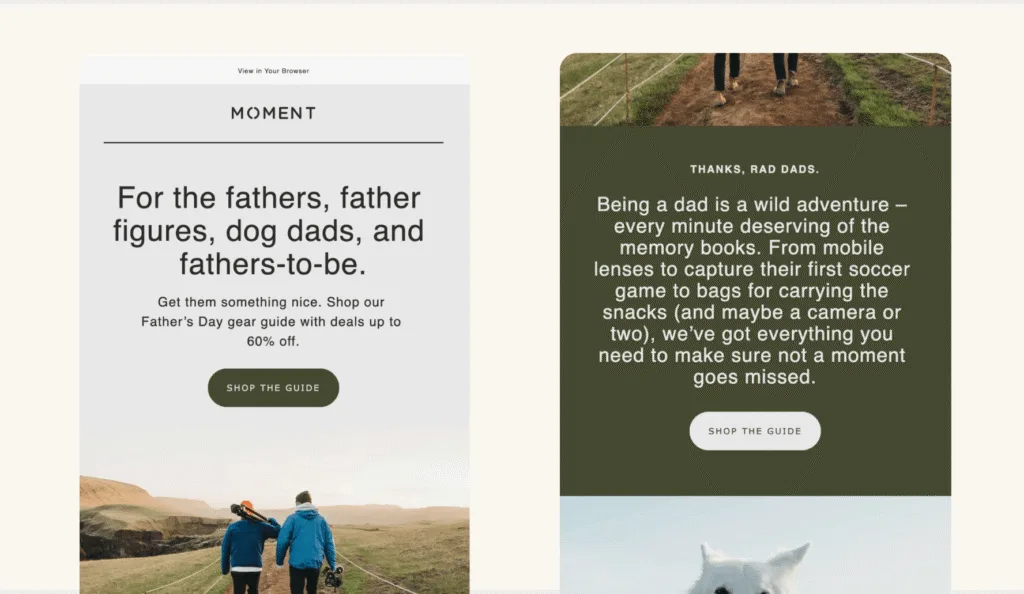
💡 Last thought:
“What about those opt-out emails ahead of Father’s Day? Should we do those?”
You know those opt-out emails that say “Father’s Day can be tough for some people, feel free to opt out”?
In theory, we love them.
Showing empathy for your audience and acknowledging the plurality and nuance of people’s experiences with emotionally heightened days? Love that. All the time in the world for that.
However…
Now they’ve kinda become the norm, in practice, they’re actually extending the period of time that people who don’t want to be reminded of Father’s Day (or any other day) have an inbox full of reminders.
That’s why we love what Bloom & Wild have done with this page.
And with this email they sent last year (ahead of all the Father’s Day noise and with no reference to Father’s Day 🙌).
(I know I need to charge my phone.)
Empathetic, giving the customer complete autonomy and inviting feedback from their customers that they’re getting it right?
Full marks. 👏
Dive into more free tips and tricks 👇
How Starface use orthography to build a killer brand voice their customers love
The words you write matter. But so do your full stops, emojis and lowercase letters. Learn how to turn punctuation into a powerful part of your brand voice.
Why Oatly’s brand voice is so damn good (and how yours can be, too)
We dig into the three layers of brand voice (10,000ft, 1,000ft, ground level), show how Oatly nails each one and how you can do it for your own brand.
The weekly newsletter that takes your brand’s copy from “meh” to “hell f*cking yeah!”
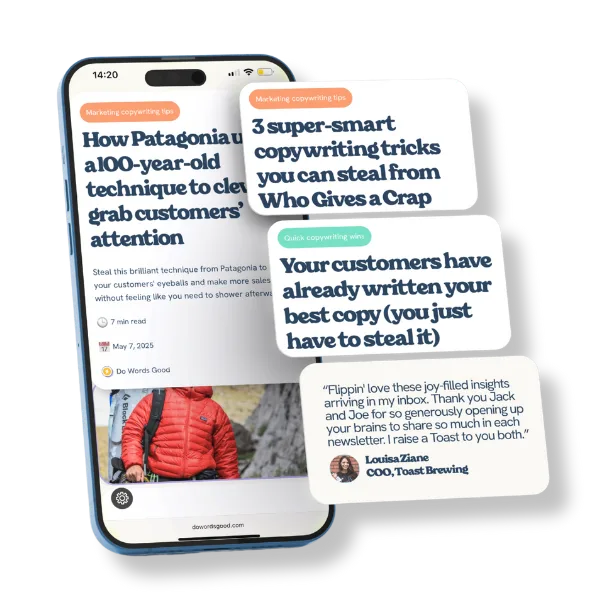
Read every week by legends at brands like these











